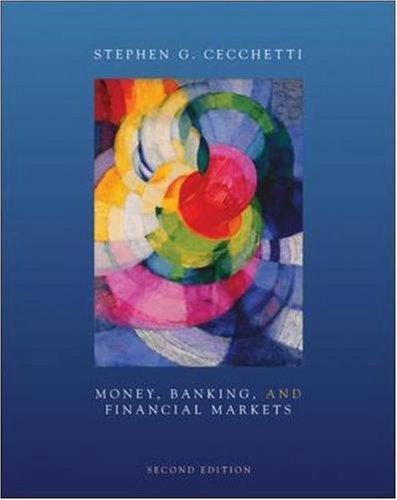Question
1. The dividend-growth model may be used to value a stock: Round your answers to the nearest cent. $ $ $ $ $ What is
| 1. The dividend-growth model may be used to value a stock: Round your answers to the nearest cent. $ $ $ $
$
| ||||||||||||||||||||||||||||||||||||||||||||||||
| 2. Last year Artworks, Inc. paid a dividend of $4.20. You anticipate that the companys growth rate is 5 percent and have a required rate of return of 12 percent for this type of equity investment. What is the maximum price you would be willing to pay for the stock? Round your answer to the nearest cent. $ | ||||||||||||||||||||||||||||||||||||||||||||||||
| 3. An investor with a required return of 15 percent for very risky investments in common stock has analyzed three firms and must decide which, if any, to purchase. The information is as follows:
Stock A: $ Stock B: $ Stock C: $
%
Stock A: $ Stock B: $ Stock C: $
| ||||||||||||||||||||||||||||||||||||||||||||||||
4.
| ||||||||||||||||||||||||||||||||||||||||||||||||
| 5. Jersey Jewel Mining has a beta coefficient of 1.7. Currently the risk-free rate is 1 percent and the anticipated return on the market is 6 percent. JJM pays a $4.30 dividend that is growing at 4 percent annually. Do not round intermediate calculations. % $ The stock -Select-isis notItem 3 overvalued and -Select-shouldshould notItem 4 be purchased. $ The stock is -Select-overvaluedundervaluedItem 6 and -Select-shouldshould notItem 7 be purchased.
| ||||||||||||||||||||||||||||||||||||||||||||||||
| 6. The risk-free rate of return is 4 percent, and the expected return on the market is 8.4 percent. Stock A has a beta coefficient of 1.3, an earnings and dividend growth rate of 5 percent, and a current dividend of $2.60 a share. Do not round intermediate calculations. Round your answers to the nearest cent.
$
The stock -Select-shouldshould notItem 2 be purchased. $ $ $ The increase in the return on the market -Select-increasesdecreasesItem 6 the required return and -Select-increasesdecreasesItem 7 the value of the stock. The increase in the risk-free rate and the simultaneous increase in the return on the market cause the value of the stock to -Select-increasedecreaseItem 8 . The decrease in the beta coefficient causes the firm to become -Select-lessmoreItem 9 risky as measured by beta, which -Select-increasesdecreasesItem 10 the value of the stock.
| ||||||||||||||||||||||||||||||||||||||||||||||||
| 7. The security market line is estimated to be k=4% + (13% - 4%). You are considering two stocks. The beta of A is 1.6. The firm offers a dividend yield during the year of 4 percent and a growth rate of 5.2 percent. The beta of B is 2.0. The firm offers a dividend yield during the year of 4.7 percent and a growth rate of 4.7 percent. Stock A: % Stock B: % The difference in the required rates of return is the result of -Select-stock Astock BItem 3 being riskier. Stock A -Select-shouldshould notItem 4 be purchased. Stock B -Select-shouldshould notItem 5 be purchased. -Select-Stock AStock BNeither of stocksBoth stocksItem 6 should be purchased.
| ||||||||||||||||||||||||||||||||||||||||||||||||
| 8. Two stocks each currently pay a dividend of $1.70 per share. It is anticipated that both firms dividends will grow annually at the rate of 5 percent. Firm A has a beta coefficient of 0.97 while the beta coefficient of firm B is 1.11. Stock A: $ Stock B: $ The beta coefficient of -Select-stock Astock BItem 3 is higher, which indicates the stock's return is -Select-lessmoreItem 4 volatile. Stock A is -Select-undervaluedovervaluedItem 5 and -Select-shouldshould notItem 6 be purchased. Stock B is -Select-undervaluedovervaluedItem 7 and -Select-shouldshould notItem 8 be purchased.
| ||||||||||||||||||||||||||||||||||||||||||||||||
| 9. The dividend-growth model, suggests that an increase in the dividend growth rate will increase the value of a stock. However, an increase in the growth may require an increase in retained earnings and a reduction in the current dividend. Thus, management may be faced with a dilemma: current dividends versus future growth. As of now, investors required return is 11 percent. The current dividend is $1.2 a share and is expected to grow annually by 4 percent, so the current market price of the stock is $17.83. Management may make an investment that will increase the firms growth rate to 8 percent, but the investment will require an increase in retained earnings, so the firms dividend must be cut to $0.9 a share. Should management make the investment and reduce the dividend? Round your answer to the nearest cent. The value of the stock -Select-risesdeclinesItem 1 to $ , so the management -Select-should notshouldItem 3 make the investment and decrease the dividend. |
Step by Step Solution
There are 3 Steps involved in it
Step: 1

Get Instant Access to Expert-Tailored Solutions
See step-by-step solutions with expert insights and AI powered tools for academic success
Step: 2

Step: 3

Ace Your Homework with AI
Get the answers you need in no time with our AI-driven, step-by-step assistance
Get Started


